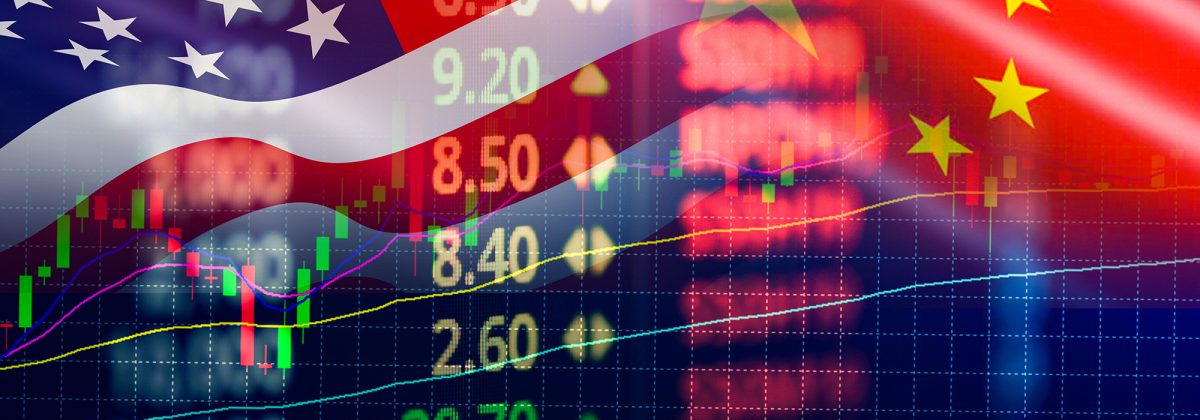Why CFD Trading is a Good Option Against the Backdrop of the US China Trade War

As the United States and China fail to agree on a compromise, fears of huge repercussions on the global economy rise. The International Monetary Fund’s World Economic Outlook Report, released in April 2019, lowered the global economic growth forecast for 2019 to 3.3%, from the earlier 3.6%. Economic growth has already been impacted for both China and the US.
The ongoing trade war escalations are projected to shave off 0.4% from the economic growth in China and 0.8% from that of the US. In August 2019, the trade war took a turn towards a full-fledged currency war. The USD/CNY pair went down to below 7.00, for the first time since 2008.
So, how should investor deal with such volatility, fuelled by the trade tensions? Trading derivatives like Contracts for Difference (CFDs) could be a safer strategy, since CFDs allow you to trade both bull and bear markets.
Extreme Market Volatility on the Rise
The morphing of the trade war into a currency war has sparked widespread volatility in the financial markets. Mounting costs of doing businesses for companies have led to investors fearing a “flash crash” in the markets in the near future. In May 2019, the Organisation for Economic Cooperation and Development (OECD) warned that uncertainties due to trade disputes between the US and other countries were causing a downturn in global investments and market sentiment. According to its reports, global investment would rise only 1.7% in 2019-20, much below the 3.5% growth registered in 2017-18.
The most worrying aspect for traders is the continuous ups and downs in the markets, owing to rapid developments. News regarding failure of talks between country leaders results in declining markets, while stalling trade sanctions translates into uptrends.
On August 30, 2019, the US Dollar Index rose 0.45%, while offshore Yuan was trading at the lowest levels in 25 years, as news regarding the launch of new retaliatory tariffs by the two countries from September 1, 2019, did the rounds.
Again, on September 5, 2019, the financial markets soared, with President Trump’s decision to start talks with the Chinese government once again. The S&P 500 jumped more than 1%, a welcome sign for the stock market, after it had declined through most of August.
The Eurozone suffers too. The Euro fell to a two-year low on September 2, 2019, trading at $1.095. The Great British Pound has been in crisis mode amidst Brexit fears. Analysts fear that expectations of the European Central Bank slashing interest rates in mid-September 2019 could lead to further declines.
It is becoming evident now that continued talks tend to soothe the markets, while escalation has the opposite effect. For traders, buying and selling according to President Trump’s whims has almost become a norm. A potential strategy to survive the markets during this period of volatility could be CFD trading.
Trading Volatile Markets Becomes Simpler Through CFDs
Derivatives like Contracts for Difference (CFDs) allow traders to speculate on price movements of assets, without actually having to own the underlying asset. These assets could range from shares to stock indices and currencies to commodities. One of the best things is that a trader gets a comprehensive view of the market from a single platform. Most CFD brokers offer solutions on MT4 and MT5, which allow the use of effective technical analysis tools to make informed trading decisions.
In essence, CFDs offer the flexibility to trade in both bear and bull markets. Unlike some other instruments that impose restrictions on short trading, in CFDs, one can enter into short positions in falling markets. Many traders use these instruments to hedge their existing portfolios, during periods of short-term volatility. Traders can go both long and short on an asset, based on whether they expect the price to rise or fall.
Margin trading is another important critical advantage, which means traders can trade without having to invest the full value of the position. It increases the profit potential. However, leverage is business, and an unfavourable market turn could lead to magnified losses. It is possible for the losses to exceed the initial investment too.
Like any other instrument, strong risk management tools are necessary for CFD trading as well.
Risk Management Strategies for CFD Trading
CFD trading is fast moving and requires continuous monitoring, especially in volatile conditions. As previously mentioned, major news trends and macroeconomic releases lead to fluctuations in the market. These are indeed tough times for the financial markets, and one must tread carefully. Some useful strategies for managing risks are:
1. Stop-Loss
In volatile conditions, prices move rapidly, as a result of which market gaps can occur frequently. Putting a stop-loss at the right level can prevent losses from mounting, in case the market decides to make a U-turn. It will react faster than a trader, negating any aspect of human bias or emotions.
2. Correct Order Sizes
It is important to choose your order size carefully, one that allows you enough capital to outlast the market movements.
3. Leverage
There is a reason why major financial regulatory bodies have limited leverage offerings on CFD instruments. Choosing a crazy leverage amount could wipe off the entire account when there is a market reversal. This is why it is important to trade with a regulated broker, who offers sound leverage and robust risk management tools.
4. Trailing Stops
Traders can track market movements by setting price points below or above the market price, at which the position needs to be closed out. Trailing stops or trailing stop-losses consider the prevailing market trend, locking in profits and minimising losses when the markets move in the opposite direction. So, a trailing stop will not only lock-in any earnings on a trade, but also set caps on the losses when trades don’t work out. This is an ideal combination of trade and risk management.
Lastly, it is vital for traders to be keep an eye on major news events. Global leaders like President Trump have the power to move markets even with their social media commentaries. A 360-degree view of the global economy is imperative before orders are made, irrespective of the asset or country one is trading from.
Reference Links
- https://www.scmp.com/comment/opinion/article/3015035/us-china-trade-war-pushing-world-economy-closer-edge-longer-it-goes
- https://www.cnbc.com/2019/08/30/forex-markets-us-china-trade-war-in-focus.html
- https://markets.businessinsider.com/news/stocks/china-exports-share-gains-on-weak-renminbi-asia-shipments-blunt-trump-tariffs-1028483675
- https://www.nytimes.com/2019/09/05/business/markets-trump-china-trade.html
- https://www.euronews.com/2019/09/03/stocks-hurt-by-trade-war-pound-hit-by-no-deal-brexit-fears
- https://www.investopedia.com/articles/stocks/09/trade-a-cfd.asp
- https://www.thebalance.com/trailing-stop-1031394




